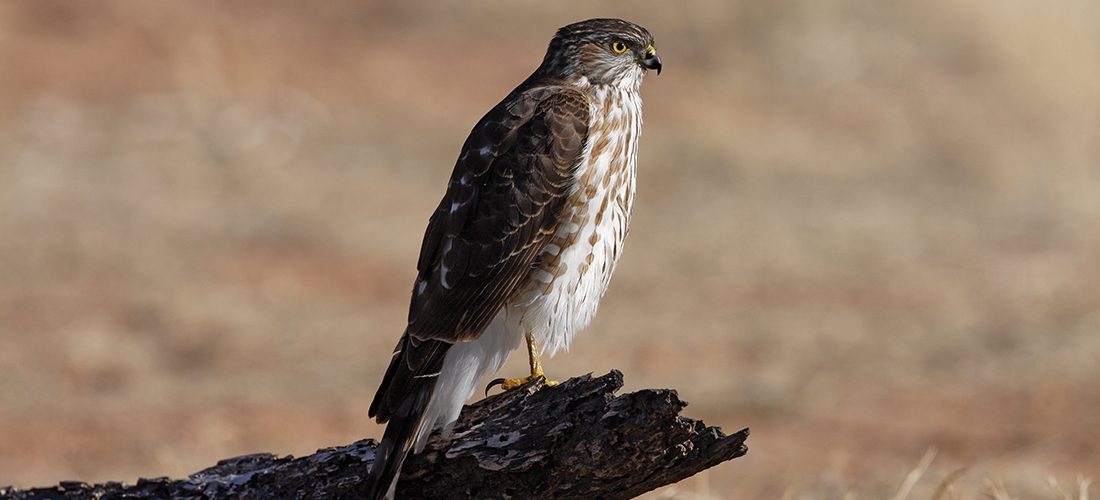
Fine Young Cannibals
Beware the stealthy Cooper’s Hawk
By Susan Campbell
To some, a hawk is a hawk. Yet here in the Piedmont and Sandhills of North Carolina, we have 10 different species of these feathered hunters in our area during the course of the year. There are the fast-flying, powerful falcons. Also, you can spot large buteos over open terrain. Around lakes and along the coast, look for fish-eating osprey. And, in addition, there are the less understood, ultra maneuverable bird hawks, known to birders as accipiters (from the Latin “accipere,” to grasp or take).
Slender, fast-moving bird hawks such as Cooper’s hawks and the slightly smaller sharp-shinned hawk are tough to spot and even more difficult to identify. Both can be seen in our area 12 months of the year. Consider that anyone who feeds songbirds will, like it or not, be providing for these ubiquitous bird-eaters’ welfare.
To differentiate the two species, one needs good binoculars and more than a little good luck in order to get a good enough view to make the call. A keen eye and being in the right place at the right time can, however, be very rewarding.
Adult Cooper’s are handsome with slate-gray back and fine, red barring along the breast and belly. The large head is a dark gray and is set off by a paler neck. Feathers on the crown are often held erect, giving the birds an almost regal hooded appearance. The tail is somewhat rounded and barred with alternating brown-and-black bands with a narrow white tip. The legs too are relatively long and yellow with very strong and sharp talons. The sexes of Cooper’s hawks are identical in appearance with the exception that the females are approximately 15 percent larger than males. As a result, males must be cautious, even around their mates, since they are in the size range of prey that females may take. They will not only make submissive calls but listen for reassuring vocalizations from the female during the breeding season to be assured of their safety. Young birds have brown streaking on the breast and belly, which may take up to two years to be replaced by adult plumage. So as is common with the larger hawks, yearling Cooper’s may not breed until their second summer.
As with other accipiters, Cooper’s hawks are adapted to hunting in closed canopy forest. Their shorter, rounded wings and long tail make them well-suited to moving through forested habitat. They will commonly fly low to the ground and then precipitously maneuver up and over obstacles to ambush prey on the far side. They also hunt on the ground, walking about through thick cover looking for sparrows and other smaller birds hidden within.
Cooper’s hawks have one brood in late spring to early summer. The male constructs the large stick nest high in a mature tree during about a two-week period. Once the nesting begins, he will feed the incubating female as well as gather most of the food for the nestlings. The female Cooper’s defends the nest vigorously and broods the young birds until they are well feathered.
Although it is not uncommon for backyard birdwatchers to see one of these masterful hunters with a fresh kill, like all predators they miss more than they actually catch. Furthermore Cooper’s hawks eat a variety of prey including squirrels and other rodents. The birds they do catch tend to be the most common species such as mourning doves and, in more urban locations, rock doves (pigeons) and European starlings, none of which are at all in short supply even in our area.
Cooper’s hawks were one of the species negatively affected by DDT usage in the middle of the last century, but they have rebounded very well. And nowadays they are not averse to living alongside humans even in more open terrain if prey is abundant. Families of Cooper’s have been documented in the yard of folks in Whispering Pines as well as Southern Pines in recent years. Not too many people can boast of sharing a piece of woodland with one of the world’s most skillful fliers. So keep your eyes peeled and maybe you, too, will find these amazing creatures living in your neighborhood as well! PS
Susan would love to receive your wildlife observations and/or photos at susan@ncaves.com





